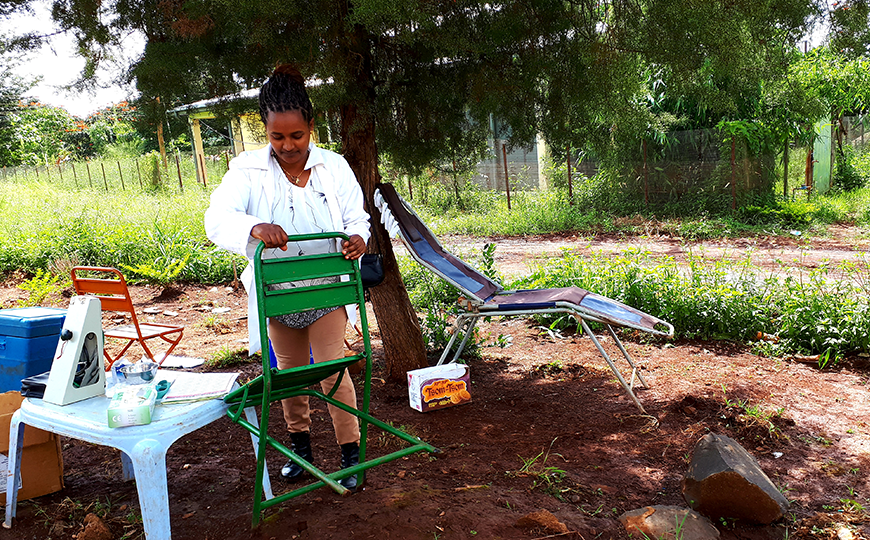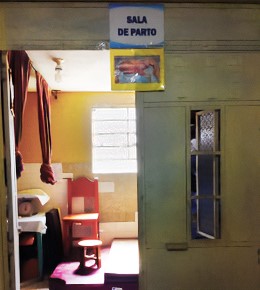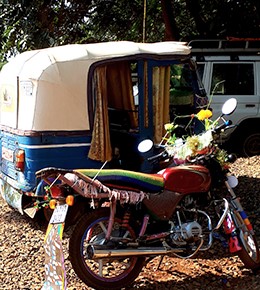https://www.infirmiere-canadienne.com/blogs/ic-contenu/2025/09/15/pays-du-sud
‘Much purer’ practice relies heavily on ‘instincts, knowledge, clinical presentations, epidemiological patterns, and physical assessment skills’
 Courtesy of Ashley Holloway
Courtesy of Ashley Holloway
Ashley Holloway concludes her article by saying, “I cannot help but think that perhaps those health-care workers practising their craft in the Global South have so much to offer us — and are perhaps farther ahead than we are — in many aspects.” Above: a blood clinic at Assosa General Hospital in Assosa, Ethiopia.
The hammering of the nails into the coffin could be heard throughout the hospital.
When there is a death, it is tradition for the family and friends of the deceased to gather in the hospital corridor in large numbers. The coffin is built around the body as soon as the supplies can be mustered, as if somehow to contain death.
I remember there being an exceptional number of people present in the corridor that day, the death a result of the ethnic violence that had erupted between Tigrayan militants against the government in Assosa, Ethiopia, where I worked as a nurse for a time several years ago.
 Courtesy of Ashley Holloway
Courtesy of Ashley Holloway
A delivery room in rural Totonicapán, Guatemala
With hospital staff, including myself, caring for the victims of both sides of the conflict, I remember feeling the weight of tension as I walked through the open-air corridors. Working among these conditions revealed the importance of empathy and the simple power of holding a patient’s hand.
Another victim is wheeled by on a stretcher, his body covered with a sheet, a trail of people following quietly. The rickety stretcher upon which the body lies is without any mattress or cushion; such luxuries are not available here.
An unspoken truce between both sides of the ethnic conflict has been declared on the hospital grounds, yet despite the assurances from my colleagues that we are safe, I remain nervous. We are the ones picking up the pieces from the violence — literally and figuratively.
Grateful for being ‘protected’ from violence
The cause of this round of violence was due to a profoundly ingrained sense of injustice on both sides of the conflict. At the time, Prime Minister Abiy Ahmed, lauded by some and loathed by others, had recently been elected, fuelling the deep-seated acrimony.
The violence had stretched for days at this point, the searing heat contributing to the hostility by making people restless and agitated. The recent end of the rainy season was as abrupt as someone turning off a tap, only to be replaced with relentless heat instead.
There didn’t seem to be any happy mediums, and I remember feeling a sense of both gratefulness and disgust at how the colour of my skin and the white coat I wore served as protection from violence.
Most of the medical issues I saw while working there were the result of infectious diseases, malnutrition, or poor hygiene — or a combination thereof. Typhus was very common, as were malaria and tuberculosis.
The incidence of HIV had been rising again, and a large portion of health-care funding was focused on its prevention and education. While many of these issues would be considered preventable by Canadian standards, working in this context reinforced the importance of choice.
Distributed in rural communities for free, mosquito nets were seldom used for their intended purpose, which was to protect people from being bitten while they slept. Instead, individuals would focus on balancing the needs of today against what might happen tomorrow, thus determining how that bed net would be used.
It might instead be used to create a hammock for the new baby, or to strain the beans so the family could eat tonight. The risk that malaria may be contracted tomorrow often outweighs the needs of today. (We also see this thinking on the streets of downtown Calgary: take a hit of fentanyl now to escape the hellof life on the streets, thus staving off the horror of withdrawal, or save the money for possible recovery tomorrow.)
Choosing between the lesser of two evils
It’s easy to ignore the context of the individual making the decision, or the reasons they are making the decision they are making, but this often gives insight to what an individual truly needs or what they lack.
With that said, we are prone to assuming that poor decisions are made owing to a lack of education. Yet rarely is education a factor. People don’t wake up one day and decide to be addicted to fentanyl. They don’t decide to be poor.
After nearly 20 years as a nurse and working in different contexts and geographical locations, I see now how the choices that one is faced with dictate the choices they will make. Likewise, context is what decides the choices that people are exposed to in the first place. Choice often means choosing the lesser of two evils.
Working in many different cultures throughout my career in health care also leaves me troubled by how Western medicine arrogantly considers itself the pinnacle of modern care. Without a doubt, living in Canada with its universal, publicly funded health-care system, I am blessed with access to health care that will address my medically necessary needs without cost to myself. Living in a big city also means I am afforded access to specialists and new innovations in health care.
However, many of these innovations in health-care delivery in Canada are underpinned by technology. Of course, technology in medicine saves lives. However, it often creates a barrier to touch: we touch the equipment, and the equipment touches the patient.
Our equipment should never serve as a proxy for human touch. The act of physically touching our patients is at risk of obsolescence in the global North because of this — yet human touch is a large part of health, healing, and recovery.
A lesson in focusing on the patient’s needs
I remember accompanying a traditional Mayan midwife on her home visits in a remote community near Quetzaltenango, Guatemala, several years ago. Serving as part of a delegation of Canadian health-care providers, my role involved supporting the professional development of the midwives.
During the home visit, I observed the midwife performing Leopold maneuvers to assess the fetal position, which, in the absence of ultrasound technology, is a normal part of a prenatal visit, particularly in this region of Central America. What was unusual, though, was the length of time it took the midwife to perform the assessment, which she did over several minutes as she chatted with the patient.
The patient lived in a small, thatched hut with a dirt floor that measured approximately ten by 12 feet, perched high on a steep mountain slope. Access to running water was by way of an outdoor tap, which was considered a luxury.
 Courtesy of Ashley Holloway
Courtesy of Ashley Holloway
Typical transportation in Assosa, Ethiopia
Several small children played on the floor, curious about the obvious outsider in their midst; a few chickens scratched at the dirt. Using an interpreter as I was unable to speak K’iche, the local language, once the midwife was finished with her assessment, I asked her why she spent such a long time palpating the woman’s abdomen. Her unexpected response humbled me to my core.
She told me she did so because it was likely the only time in the woman’s day when she was the recipient of someone’s gentle touch, and when the focus was entirely on her and her needs.
Clearly, I was the one needing education in this case, and not, as I had assumed, the other way around.
A ‘purer’ form of medicine
In my experience, the practice of medicine in the Global South is much purer, with doctors, nurses, and midwives relying on their instincts, knowledge, clinical presentations, epidemiological patterns, and their physical assessment skills in place of the technology we have so ubiquitously embraced here. But to do so means touching their patients, something we are often disinclined to do in the Global North, particularly since the COVID-19 pandemic, when touching someone made you an anathema. Instead, now we surrender our assessments to technology, assuming that it will do the touching for us.
Yet, I would ask whether our reliance on technology, on these machines and monitors, risks losing the human element of medicine. We use technology to teach us empathy. We use artificial intelligence and algorithms to make decisions in medicine, which some might argue risks replacing clinical judgment. Telehealth allows us to connect with patients we would otherwise not see, likely because of geographical limitations. Yet, our visual fields through a screen provide only one aspect, one dimension, of a patient assessment.
We use technology to monitor and interpret human behaviour, and robots provide health care. The Devil’s advocate might argue whether the mere existence of these technologies and their uses signal a much deeper societal issue.
The hospital I worked at in Ethiopia did not have a functioning blood pressure cuff on the medical ward, nor did the pediatric ward have an oxygen saturation monitor designed for pediatric patients, making an accurate reading very difficult.
Many of the wards had only one set of nasal prongs with which to administer oxygen; those patients with the greatest needs received it, taking turns. We also didn’t have a consistent supply of oxygen, resulting in an inability to perform surgeries. In the area where I worked with the Mayan midwives, they had an ambulance to transport labouring women to the hospital, but no gasoline. Working up above the Arctic Circle in Canada, I provided care using expired medical supplies and had to boil the water before drinking it.
No amount of physical touch would help solve these problems. However, having the opportunity to witness and compare such vastly different frameworks within which medicine is practised, I cannot help but think that perhaps those health-care workers practising their craft in the Global South have so much to offer us — and are perhaps farther ahead than we are — in many aspects.
Ashley Holloway, MPH, LPN, G.Dip. GBLD, CD, is a nurse, writer, and editor who teaches writing and health-care leadership in Calgary and serves as editorial director at Unleash Creatives.
#opinions
#care-models
#ethics
#global-health
#nursing-practice
#patient-care